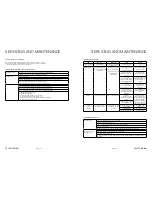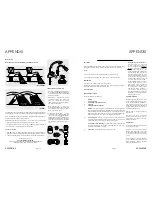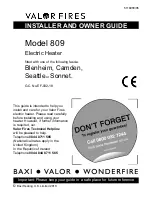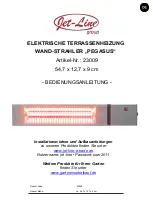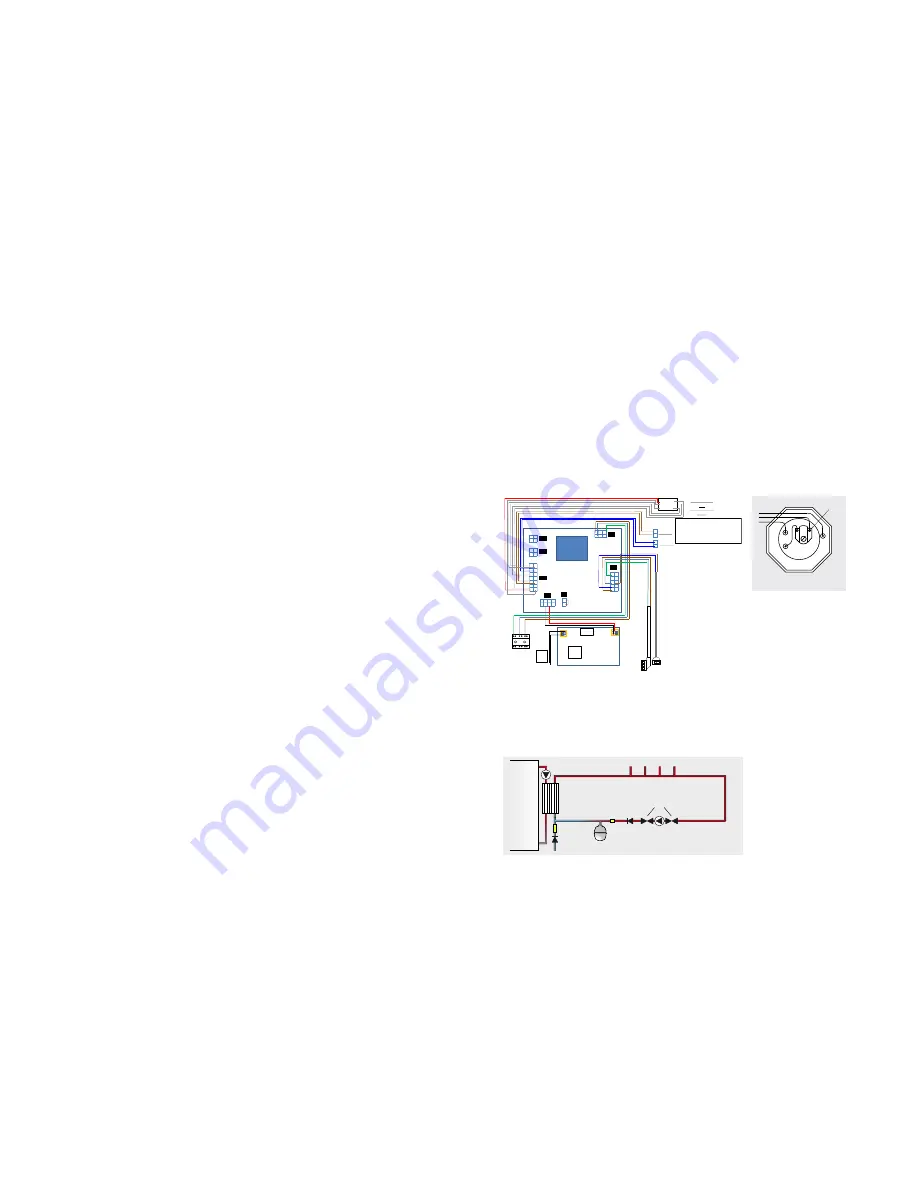
Page 10
Page 11
from any heating from the hot water pipework
to ensure that the water remains cold and of
drinking water quality.
A pipe thermostat is incorporated in the circuitry
which cuts the supply to the pump when
the water in the return pipe reaches the set
temperature. Ensure the hot water temperature
is set correctly to avoid excessively hot water at
the outlets and long pump run times.
Secondary circulation pipework must be
insulated to prevent energy loss in both heated
and unheated areas.
Immersion Heaters
These are 3kW 230V AC heaters and incorporate
a thermostat. The thermostat incorporates a
manual reset. They have incalloy elements
to prolong their life expectancy in aggressive
water conditions. We recommend best practice
of connecting the wiring to the immersion heater
is using crimp connections.
Utilising Off Peak Electricity
Where it is intended that units are fitted to
unrestricted offpeak circuits, then suitable
controllers such as the Horstmann off peak electric
time controller will be required. External wiring
to the immersion heaters must be in accordance
with the relevant IEE Wiring Regulations and the
circuit must be protected by a suitable 16A MCB
fuse and a 20A double pole isolating switch.
Safety
The immersion heaters must be earthed and they
must be isolated from the mains before the cover
is removed on every occasion. Replacement
immersion heaters should be obtained from
Gledhill Building Products Limited.
Important
The unit must not be powered up unless the
thermal store has been filled with water, the
pump has been bled and water is confirmed
to be present in the pipework above the pump.
Wiring The Control Panel
The control panel requires a separate 3 amp fuse spur double pole to ensure safe
isolation. The cable/flex from the fuse spur to the control panel must be a minimum
of 0.75mm
2
C.S.A. and be heat resistant. The cable should be clipped to prevent
accidental snagging.
The control panel front cover is secured by 4 screws. Remove these and lift off the
front cover to expose the power terminals. These are found at the bottom left of the
control panel. Prepare the cable end and feed it through the cable gland.
Use a screwdriver to press the neutral cross down on the WAGO connector. This opens
the clamp and the neutral wire can be fed into the connector. Remove the screwdriver
and test the wire is securely fit. Repeat with the PE and live cables. Tighten the cable
gland and check for security. Perform the necessary safety checks and refit the front
panel.
Secondary Hot Water Circulation
If the length of the hot water draw-off pipework is excessive and the delivery time
will be more than 60 seconds before hot water is available at the tap, you may wish to
consider using trace heating to the hot water pipework such as the Raychem HWAT
system. Also a conventional pumped secondary circulation system (shown below)
can be used with any model of the Torrent Stainless.
It is important that the cold water pipework is adequately separated and protected
Pipe Layout
In all mains pressure installations it is important to remember that the incoming cold
supply must be shared between all terminal fittings. It is important that a 22mm supply
is brought to the appliance and a 22mm take-off is continued at least to the bath.
If there are two baths, 28mm pipework should be considered. One metre of smaller
diameter pipework, or flow restrictors, should be provided on the final connection to
all outlets so as to balance the water available. In any event the distribution pipework
should generally be in accordance with BS EN 806:3.
Plastic Pipework
All the recommendations with regard to the heating systems in this manual are
generally based on BS/EN Standards copper pipework and fittings. However plastic
pipework system can be used in place of copper as long as:-
a. The chosen system is recommended for use in domestic heating systems by the
manufacturers and it is installed fully in accordance with their recommendations.
b. The design criterion of the plastic system is at least equivalent to the use of BS/EN
Standards copper pipework and fittings.
c. Barrier pipework for these systems is recommended.
Ball Valve and Overflow
The feed and expansion tank can be filled manually if required e.g. using a hose pipe
fitted with a double check valve.
In this situation an overflow pipe can still be fitted if required to ensure that if a leak occurs
on the plate heat exchanger it can be discharged safely to the outside of the building.
Note: If a ball valve is fitted, then a warning/overflow pipe must always be fitted.
The feed and expansion tank (provided by the installer) must be sized correctly to
enable the expansion of the entire system volume. This will include the central heating,
store, solid fuel and boiler circuit volumes.
See page 12 for guidance sizing the feed and expansion tank.
Water Treatment
In all Torrent Stainless models, the primary (i.e. non-potable) water is stored and the
domestic hot water is heated instantaneously by means of heat exchangers. Therefore
treating the primary water will not contaminate the domestic hot water supply.
Although the Torrent Stainless primary store has no special water treatment
requirements, the radiators and other parts of the circuit will require the application of
a scale and corrosion inhibitor. The only Fernox products that arent compatible are the
Flux and to a lesser extent some of our Acidic Cleaning products, namely DS40. This is
because the Chloride in Flux can cause pitting in even Duplex Steel. The volumes and
concentration should be calculated in accordance with the manufacturers instructions
and when calculating the system volume (i.e. the water content), the volume of the
Torrent Stainless should be taken into account.
Use In Hard Water Areas And Scale Protection
The patented design of the domestic hot water plate heat exchanger is such that
the turbulence through the plates slows down the formation of scale in moderate
hard water conditions. However, the requirements set out in the ‘Domestic Building
Services Compliance Guide’ and the Building Regulations approved documents L1A
and L1B regarding scale protection should be complied with.
INSTALLATION
INSTALLATION
INSTALLATION
INSTALLATION
Thermostat
Immersion Heater Wiring
E
L
N
These requirements state that; “where the mains
water hardness exceeds 200ppm provision should
be made to treat the feed water to the water
heaters and the hot water circuit of combination
boilers to reduce the rate of accumulation of
scale”. To comply with this requirement: -
a. The hardness of the mains water should be
checked by the installer and if necessary a
suitable in-line scale inhibitor device should
specified for hardness levels between 200
and 300ppm (mg/l).
b. Where the hardness level is 300ppm (mg/l) and
above, the optional phosphate type inhibitor
should be specified and fitted at a suitable
point in the cold water supply to the appliance.
It is important that where the supply to the
Torrent Stainless is in 22mm the in-line scale
inhibitor is also 22mm. In practice servicing is not
normally required but in hard water areas, the
requirements can be considered similar to those
needed for instantaneous or ‘combi’ appliances.
The installation of scale inhibitor should be in
accordance with the manufacturers instructions
and Water Byelaws.
London Loop
As the thermal store gets hot the water will
expand and the water level in the F&E tank will
rise, as will the level of water in the vent pipe.
Hot water will also rise to the top of the cylinder.
When the water at the base of the cylinder
becomes hotter it may run out the cold feed
connection pipe. If the cold feed pipe then runs
vertically it works like a chimney with the hot
water rising to the top in the same way hot air
does from a fire. If this section is not insulated
then it will lose heat and waste energy.
If, however, the cold feed is formed into a sheppard’s
crook or london loop it will form a thermal trap. A
thermal trap works by ensuring that cold water is
held below hot water. Because hot water always
rises it will not be able to move down and around
the loop/crook and therefore will not rise up the
cold feed pipe work. This will reduce heat loss and
thereby prevent energy waste.
The minimum depth of the U trap is calculated by
multiplying the pipe diameter by 8. For example;
• Using 22mm pipework will require a
minimum of 176mm
22mm pipework is highly recommended to
ensure that the London loop does not air lock
during the commissioning process. It also
enables a faster installation of the product due
to the increased filling rate.
1
2
3
4
5
6
7
8
9
10
11
12
13
14
1
2
3
4
1
2
3
4
1
2
3
4
5
6
7
8
1
2
1
2
3
4
5
6
7
8
9
1
10
2 3
4 5 6
J18
J20
J19
J3
J7
J8
J1
TS sensor
GND GND
IN OUT
T1 T2
1
2
CW sensor
1
2
Combined flow
and
HW temperature
sensor
L - Brown
PR61
E – G/Y
N - Blue
PW
M
-
PW
M
+
SP
ARE
Fuse
Dip
Sw
itc
h
1 2 3 4
To
DHW
pipe
All the these sensor inputs carry a
Voltage of 5V.
The max cable length is 1 meter.
The sensors connected to the control
Should be free from the appliance earth
Torrent Stainless
Inline filter &
flow regulator
Single check
valve
Single
check
valve
Pump isolation
valves
Cold water inlet
Plate heat exchanger
Hot water outlets
Pipework length and
diameter to suit
property demands
Pipework length and
diameter to suit
recirculation flow rate
approx 1-2 l/min
Cold water sensor
Control
stat
Flow sensor
Potable water
expansion vessel
Secondary
circulation
pump
Summary of Contents for Torrent Stainless OV
Page 22: ...Page 42 Page 43 NOTES NOTES ...



















